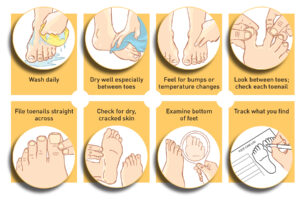Foot and leg problems are very common for people with Diabetes. Problems with the feet and legs can be very difficult to treat if they are not detected and managed early.
Diabetes can cause decrease circulation in the feet and lower legs which means any wounds sustained can take a very long time to heal. Diabetes can also cause nerve damage in the extremities, also known as ‘diabetic neuropathy’. This can make the feet less sensitive to pain or to extreme temperatures, meaning that wounds such as cuts, abrasions or burns may go unnoticed.
It is important to get into the habit of regularly checking your feet for:
- Skin tears, cuts or abrasions
- Blisters, corns or calluses
- Thickened or discoloured nails
- Ingrowing toenails
- Any red, swollen, warm or tender areas
- Any areas that are blue, bruised or swollen
- Paronychia (infection around the nails)
- Fungal infections between the toes
If you have poor vision, you should ask someone to check your feet for you.
It is important to wash your feet daily and dry them thoroughly, especially between the toes. Keep your feet moisturised, but avoid putting lotion between the toes. Your toenails should be cut straight and any rough edges filed away.
Injuries that are not treated can quickly develop into ulcers or even become gangrenous. If you do find a cut or other injury, clean the area with an antiseptic solution such as Betadine or Savlon, cover it with a clean bandage and seek advice from your GP or Practice Nurse.
Everyone with Diabetes should also have an annual foot check with a podiatrist. As you get older, you may require more frequent visits with a podiatrist, depending on the condition of your feet and your ability to check them yourself.




